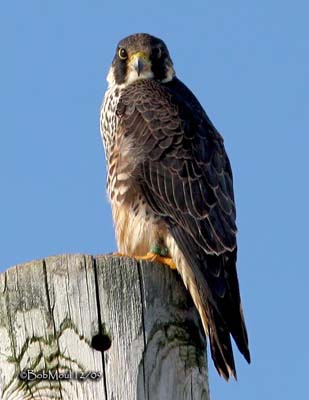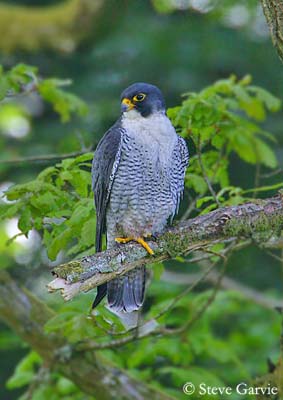
Peregrine Falcon
Falco peregrinus
Falconiforme Order – Falconidae Family
BIOMETRICS:
Length: 37-50 cm
Wingspan: M : 87-100 cm – F : 110-114 cm
Weight: 550-1500 g
PROTECTION / THREATS / STATUS:
Peregrine Falcons adults may be killed by large birds, such as Great-Horned Owls, and Golden Eagles. Chicks and young are killed by cats, bears or foxes. Eggs are taken by humans for falconry.
Peregrine Falcon is vulnerable to pesticides, because it is almost at the top of the food chain.
Fr: Faucon pelerine
All : Wanderfalke-peregrinus
Esp : Halcón Peregrino
Ital: Pellegrino
Nd: Slechtvalk
Russe: Сапсан
Sd: Pilgrimsfalk
Photographers:
Steve Garvie
RAINBIRDER Photo galleries
Tom Merigan
Tom Merigan’s Photo Galleries
Bob Moul
Nature Photography
Text by Nicole Bouglouan
Sources:
HANDBOOK OF THE BIRDS OF THE WORLD Vol 2 by Josep del Hoyo-Andrew Elliot-Jordi Sargatal - Lynx Edicions - ISBN: 8487334156
THE HANDBOOK OF BIRD IDENTIFICATION FOR EUROPE AND THE WESTERN PALEARCTIC by Mark Beaman, Steve Madge - C.Helm - ISBN: 0713639601
BIRDS OF PREY OF AFRICA AND ITS ISLANDS by Alan and Meg Kemp - Struik Publishers - ISBN: 1770073698
GUIDE DES RAPACES DIURNES – Europe, Afrique du Nord et Moyen-Orient de Benny Génsbol – Delachaux et Niestlé – ISBN : 2603013270
Pájaros de España (JL Beamonte)
Animal Diversity Web (University of Michigan Museum of Zoology)
Birds in backyards (Birds Australia and Australian Museum)
The Peregrine Fund – World Centre for Birds of Prey

DESCRIPTION:
Peregrine Falcon adult male has dark bluish-grey upperparts, with paler area on lower back to uppertail coverts. Tail is long, with grey and white bars.
Underparts are whitish on upper breast and throat. Lower breast, belly and vent are greyish, with extensive black barring. Underwings are barred black and white. Wings are long and pointed.
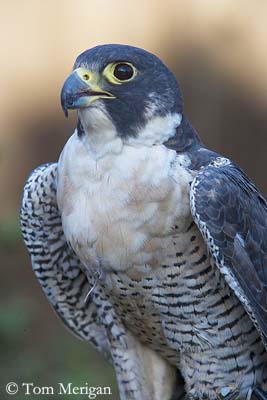
Peregrine Falcon has black crown and nape, and broad black moustache contrasting with white cheeks. Eyes are dark with broad yellow eye ring. Bill is grey with black tip and yellow cere. Legs and feet are yellow.
Both sexes are similar, with female larger and heavier than male.
Juvenile is brown overall. Underparts are yellowish-buff, streaked with dark. On upperparts, the brown feathers are edged paler. Cere and eye ring are duller than in adults.
There are about 19 subspecies throughout the world, separated on size and colour.
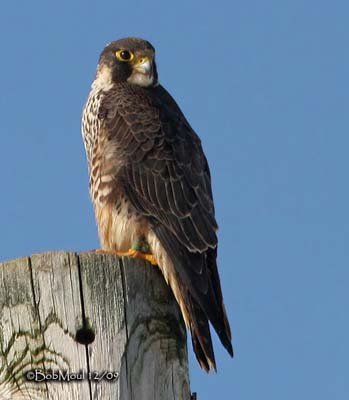
VOICE: SOUNDS BY XENO-CANTO
Peregrine Falcon is usually silent, except near the nest. Its frequent call is a loud, harsh, scolding “ka-yak, ka-yak, ka-yak…” becoming a shrill “kek-kek-kek” when alarmed.
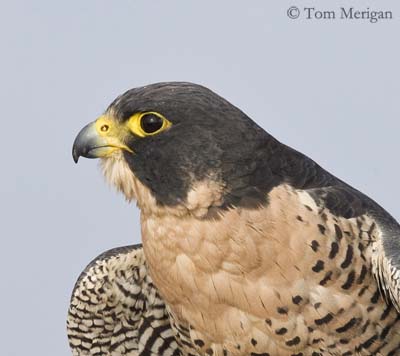
HABITAT:
Peregrine Falcon breeds on cliffs and crevices, mountains, sea costs and now, they begin to nest on tall buildings in urban areas. They may breed as high as 3600 metres, observed in Rocky Mountains, in North America.
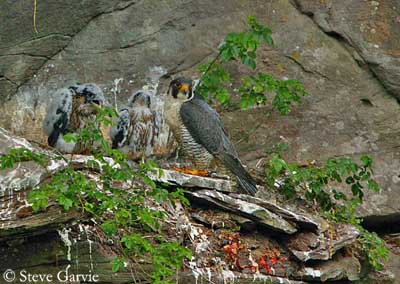
It is visible from sea-level up to 4000 metres of elevation.
In winter, they live in open lowlands, estuaries and wetlands.
RANGE:
Peregrine Falcon is found in all parts of the world, except in cold and dry Arctic regions and rainforests. Most of populations are resident and do not migrate. Birds from north and north east are migratory.
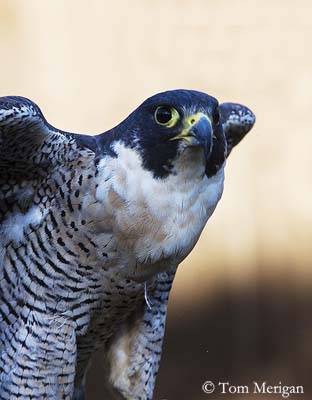
BEHAVIOUR:
Peregrine Falcon hunts mainly at dawn and dusk. It strikes and captures birds in mid-air, in open space. We can often see them hunting over open water, marshes, fields and tundra.
It may hunt on the wing or from a high perch. It spots its prey with its keen sight, and then, it starts its stoop, a streamlined dive, with tail and wings folded, and feet lying back, ready to hit the prey with its foot. It stuns or kills it and it swoops back to catch it in mid-air. When the prey is too heavy, Peregrine Falcon lets it fall to the ground, and eats it there. It plucks its prey before to eat.
They often miss their strikes and prey escapes.
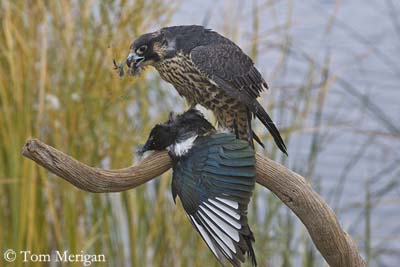
Peregrine Falcon soars to a great high, and dives at speeds of up to 320 to 380 km/hour. It controls its dive, captures the prey and lands in its own right. It may also hunt on the ground, on foot, to capture lizards, insects or mammals.
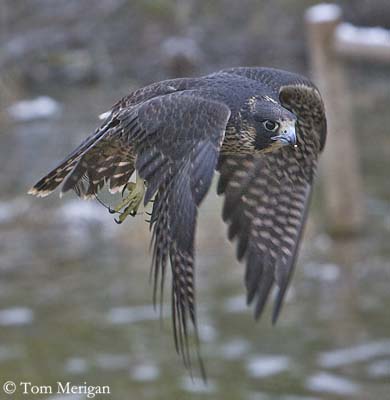
Peregrine Falcons stay together for life, and return to the same nesting site year after year. Courtship displays are spectacular, with wonderful aerial displays. Male and female climbs high in the air in order to perform an acrobatic flight, with whirling spirals and rapid dives, often touching in mid-air by talons, plumage or bill.
They roost close to each other, and male performs some preen, nibbles the female’s toes, and grabs the female’s bill in its own. Once pair is formed, they hunt together and female begs food from the male.
Peregrine Falcon is aggressive when it defends the nest. It may attack large birds and mammals.
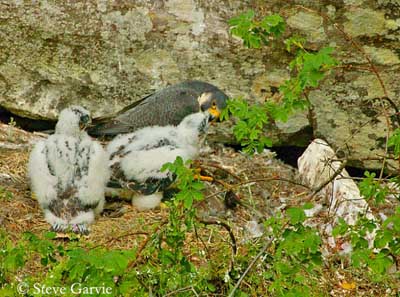
FLIGHT:
Peregrine Falcon has direct and powerful flight, with shallow wing beats. When soaring or performing direct or circled flights, wings are horizontal with slightly raised hand, forming a flat V. Its flight is very rapid, and when it dives, it may reach a speed of 380 km/heure.
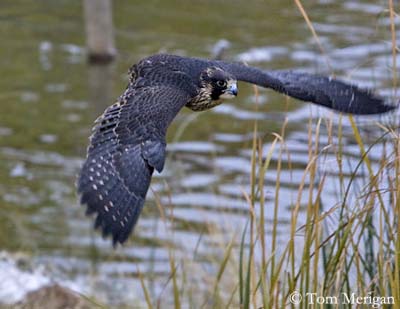
REPRODUCTION:
Peregrine Falcon breeds from late February to mid-April. Male selects the nest-site, and pair returns year after year to the same place.
They nest mainly on high cliffs, but also in towns, on ledges of skyscrapers.
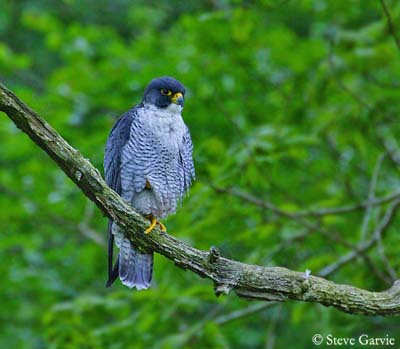
Nest is a scrape, in sand or vegetation, lined with some fine materials.
Female lays 3 to 5 creamy-white eggs, speckled with red-brown, every 48 hours. Incubation lasts about 29 to 32 days, mainly by female, but male helps sometimes and brings food at nest during this period.
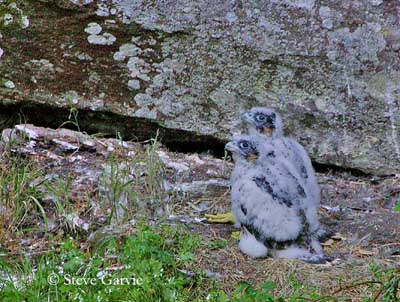
Chicks are covered in creamy-white down, and they have large feet. Male hunts for chicks and female. Female feeds the young, plucking feathers from the prey before giving to them.
Young fledge at about 35 to 45 days of age, and remain with adults for several weeks more. Young learn how to snatch some prey from parents in mid-air. They become independent at about six weeks. They reach their sexual maturity when they are 2 to 3 years old.
This species produces only one brood per year, sometimes two if the first is lost soon after laying. Second brood may be attempted after two weeks.
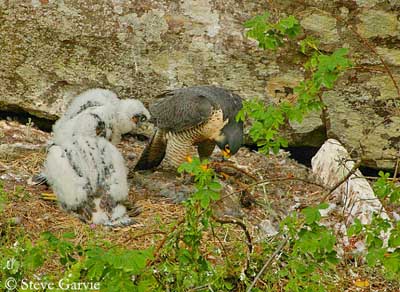
DIET:
Peregrine Falcon feeds mainly on birds, such as doves, pigeons, shorebirds, waterfowls, grouses and small songbirds. They also may eat small reptiles and mammals, such as bats, rodents, squirrels and rats. Small preys are eaten in flight.
